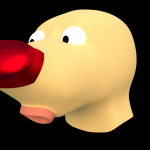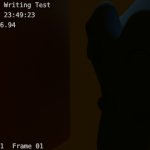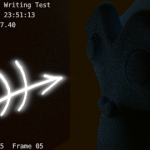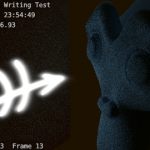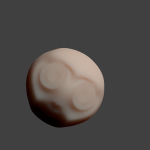This weekend I worked on the main character’s abugida a bit as well as doing some technical tests in Blender around replacement animation.
The abugida as you can see is mostly straight lines. I got the idea that it needs to be carved into unwilling surfaces with brute force so sweeping curves didn’t seem to really suit it. So far no part of any glyph takes more than five strokes to write. It’s feeling a lot more like the Korean alphabet than a genuine abugida at this point but then I guess the language I’m going to be spelling out in it isn’t anywhere close to ready yet. I want to start working up a grammar over the next few days based on the dialogue that’s already in the screenplay, figure out the translation in the abstract, then finally drop some actual words into placeholders and see how they all sound.
That’s really the end goal with the conlangs in this series – being both believable and cool to see/hear. In context, the artificial languages and scripts have a single job to do: sell the notion of richness in the universe of the story. Once they sell that notion, further polish is pretty much unnecessary. If I don’t need a word for “microchip” or a compact syntactic device to indicate that something is possibly to blame for something else, I won’t invent it. No point. Too much else to do. 🙂
So that was yesterday. Today I was feeling a bit under the weather but I loaded up Blender and had a mess around anyway.
The technical tests were mainly to get an idea of how I might go about doing replacement animation. Replacement animation is used extensively in limited animation and stop-motion but not so much in CG. The classic use for it is lipsync in stop-motion with a non-malleable medium – instead of moving the character’s face on a tiny little armature, you just whip one head/face off and put on another to get a different mouth shape for the next frame. In Blender.. well.. I’ll get back to you how it’s possible. But it is. Probably. 🙂
And if it isn’t, well.. I’ll figure something out. It’s certainly not coming easily.
I tried using the Boolean modifier to link two shapes together but it’s honestly unpredictable and didn’t really play well with the Armature modifier. The objects would randomly disappear one at a time based on rotation. Very weird.
I tried hooking vertices together as an experiment but that didn’t form a nice continuous seam, especially not when the Subsurf modifier put its two cents in.
Finally i tried Shrinkwrapping one set of verts to another but there’s not a continuous mesh anymore – annoying joins ahoy. You can see one pretty clearly starting at the bottom corner of the eye and curving around the cheek.
The end result of these tests is that I need to have more tests. That’s what tests are for.

